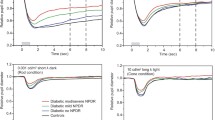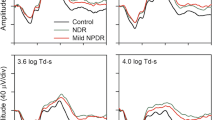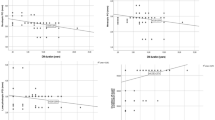Abstract
Purpose
To evaluate three measures of inner retina function, the pattern electroretinogram (pERG), the photopic negative response (PhNR), and the post-illumination pupil response (PIPR) in diabetics with and without nonproliferative diabetic retinopathy (NPDR).
Methods
Fifteen non-diabetic control subjects and 45 type 2 diabetic subjects participated (15 have no clinically apparent retinopathy [NDR], 15 have mild NPDR, and 15 have moderate/severe NPDR). The pERG was elicited by a contrast-reversing checkerboard pattern, and the PhNR was measured in response to a full-field, long-wavelength flash presented against a short-wavelength adapting field. The PIPR was elicited by a full-field, 450 cd/m2, short-wavelength flash. All responses were recorded and analyzed using conventional techniques. One-way ANOVAs were performed to compare the pERG, PhNR, and PIPR among the control and diabetic groups.
Results
ANOVA indicated statistically significant differences among the control and diabetic subjects for all three measures. Holm-Sidak post hoc comparisons indicated small, nonsignificant reductions in the pERG (8%), PhNR (8%), and PIPR (10%) for the NDR group compared to the controls (all p > 0.25). In contrast, there were significant reductions in the pERG (35), PhNR (34%), and PIPR (30%) for the mild NPDR group compared to the controls (all p < 0.01). Likewise, there were significant reductions in the pERG (40%), PhNR (32%), and PIPR (32%) for the moderate/severe NPDR group compared to the controls (all p < 0.01).
Conclusion
Abnormalities of the pERG, PhNR, and PIPR suggest inner retina neural dysfunction in diabetics who have clinically apparent vascular abnormalities. Taken together, these measures provide a noninvasive, objective approach to study neural dysfunction in these individuals.




Similar content being viewed by others
References
Lee R, Wong TY, Sabanayagam C (2015) Epidemiology of diabetic retinopathy, diabetic macular edema and related vision loss. Eye Vis 2:17. https://doi.org/10.1186/s40662-015-0026-2
Adams AJ, Bearse MA Jr (2012) Retinal neuropathy precedes vasculopathy in diabetes: a function-based opportunity for early treatment intervention? Clin Exp Optom 95(3):256–265. https://doi.org/10.1111/j.1444-0938.2012.00733.x
Lynch SK, Abramoff MD (2017) Diabetic retinopathy is a neurodegenerative disorder. Vision Res 139:101–107. https://doi.org/10.1016/j.visres.2017.03.003
Cabrera DeBuc D, Somfai GM (2010) Early detection of retinal thickness changes in diabetes using optical coherence tomography. Med Sci Monit Int Med J Exp Clin Res 16(3):MT15–MT21
Carpineto P, Toto L, Aloia R, Ciciarelli V, Borrelli E, Vitacolonna E, Di Nicola M, Di Antonio L, Mastropasqua R (2016) Neuroretinal alterations in the early stages of diabetic retinopathy in patients with type 2 diabetes mellitus. Eye 30(5):673–679. https://doi.org/10.1038/eye.2016.13
Lopes de Faria JM, Russ H, Costa VP (2002) Retinal nerve fibre layer loss in patients with type 1 diabetes mellitus without retinopathy. Br J Ophthalmol 86(7):725–728
van Dijk HW, Kok PH, Garvin M, Sonka M, Devries JH, Michels RP, van Velthoven ME, Schlingemann RO, Verbraak FD, Abramoff MD (2009) Selective loss of inner retinal layer thickness in type 1 diabetic patients with minimal diabetic retinopathy. Invest Ophthalmol Vis Sci 50(7):3404–3409. https://doi.org/10.1167/iovs.08-3143
van Dijk HW, Verbraak FD, Kok PH, Garvin MK, Sonka M, Lee K, Devries JH, Michels RP, van Velthoven ME, Schlingemann RO, Abramoff MD (2010) Decreased retinal ganglion cell layer thickness in patients with type 1 diabetes. Invest Ophthalmol Vis Sci 51(7):3660–3665. https://doi.org/10.1167/iovs.09-5041
van Dijk HW, Verbraak FD, Kok PH, Stehouwer M, Garvin MK, Sonka M, DeVries JH, Schlingemann RO, Abramoff MD (2012) Early neurodegeneration in the retina of type 2 diabetic patients. Invest Ophthalmol Vis Sci 53(6):2715–2719. https://doi.org/10.1167/iovs.11-8997
Ghirlanda G, Di Leo MA, Caputo S, Falsini B, Porciatti V, Marietti G, Greco AV (1991) Detection of inner retina dysfunction by steady-state focal electroretinogram pattern and flicker in early IDDM. Diabetes 40(9):1122–1127
Caputo S, Dileo MAS, Falsini B, Ghirlanda G, Porciatti V, Minella A, Greco AV (1990) Evidence for early impairment of macular function with pattern ERG in type-I diabetic-patients. Diabetes Care 13(4):412–418. https://doi.org/10.2337/diacare.13.4.412
Bach M, Brigell MG, Hawlina M, Holder GE, Johnson MA, McCulloch DL, Meigen T, Viswanathan S (2013) ISCEV standard for clinical pattern electroretinography (PERG): 2012 update. Doc Ophthalmol 126(1):1–7. https://doi.org/10.1007/s10633-012-9353-y
Chen H, Zhang M, Huang S, Wu D (2008) The photopic negative response of flash ERG in nonproliferative diabetic retinopathy. Doc Ophthalmol 117(2):129–135. https://doi.org/10.1007/s10633-008-9114-0
Frishman L, Sustar M, Kremers J, McAnany JJ, Sarossy M, Tzekov R, Viswanathan S (2018) ISCEV extended protocol for the photopic negative response (PhNR) of the full-field electroretinogram. Doc Ophthalmol 136(3):207–211. https://doi.org/10.1007/s10633-018-9638-x
McAnany JJ, Park JC (2018) Temporal frequency abnormalities in early-stage diabetic retinopathy assessed by electroretinography. Invest Ophthalmol Vis Sci 59(12):4871–4879. https://doi.org/10.1167/iovs.18-25199
McAnany JJ, Park JC, Chau FY, Leiderman YI, Lim JI, Blair NP (2018) Amplitude loss of the high-frequency flicker electroretinogram in early diabetic retinopathy. Retina. https://doi.org/10.1097/iae.0000000000002262
Pescosolido N, Barbato A, Stefanucci A, Buomprisco G (2015) Role of electrophysiology in the early diagnosis and follow-up of diabetic retinopathy. J Diabetes Res 2015:319692. https://doi.org/10.1155/2015/319692
Bearse MA Jr, Ozawa GY (2014) Multifocal electroretinography in diabetic retinopathy and diabetic macular edema. Curr DiabRep 14(9):526. https://doi.org/10.1007/s11892-014-0526-9
Holopigian K, Greenstein VC, Seiple W, Hood DC, Carr RE (1997) Evidence for photoreceptor changes in patients with diabetic retinopathy. Invest Ophthalmol Vis Sci 38(11):2355–2365
Tzekov R (2015) Full-field ERG in diabetic retinopathy: a screening tool? Graefes Arch Clin Exp Ophthalmol 253(7):987–988. https://doi.org/10.1007/s00417-015-3037-8
McAnany JJ, Park JC (2019) Cone photoreceptor dysfunction in early diabetic retinopathy: association between the activation phase of cone phototransduction and the flicker ERG. Invest Ophthalmol Vis Sci 60(1):64–72
Drasdo N, Aldebasi YH, Chiti Z, Mortlock KE, Morgan JE, North RV (2001) The s-cone PHNR and pattern ERG in primary open angle glaucoma. Invest Ophthalmol Vis Sci 42(6):1266–1272
North RV, Jones AL, Drasdo N, Wild JM, Morgan JE (2010) Electrophysiological evidence of early functional damage in glaucoma and ocular hypertension. Invest Ophthalmol Vis Sci 51(2):1216–1222. https://doi.org/10.1167/iovs.09-3409
Preiser D, Lagreze WA, Bach M, Poloschek CM (2013) Photopic negative response versus pattern electroretinogram in early glaucoma. Invest Ophthalmol Vis Sci 54(2):1182–1191. https://doi.org/10.1167/iovs.12-11201
Morny EK, Margrain TH, Binns AM, Votruba M (2015) Electrophysiological ON and OFF responses in autosomal dominant optic atrophy. Invest Ophthalmol Vis Sci 56(13):7629–7637. https://doi.org/10.1167/iovs.15-17951
Park JC, Moss HE, McAnany JJ (2018) Electroretinography in idiopathic intracranial hypertension: comparison of the pattern ERG and the photopic negative response. Doc Ophthalmol 136(1):45–55. https://doi.org/10.1007/s10633-017-9620-z
Feigl B, Zele AJ, Fader SM, Howes AN, Hughes CE, Jones KA, Jones R (2012) The post-illumination pupil response of melanopsin-expressing intrinsically photosensitive retinal ganglion cells in diabetes. Acta Ophthalmol 90(3):e230–e234. https://doi.org/10.1111/j.1755-3768.2011.02226.x
Park JC, Chen YF, Blair NP, Chau FY, Lim JI, Leiderman YI, Shahidi M, McAnany JJ (2017) Pupillary responses in non-proliferative diabetic retinopathy. Sci Rep 7:44987. https://doi.org/10.1038/srep44987
Obara EA, Hannibal J, Heegaard S, Fahrenkrug J (2017) Loss of melanopsin-expressing retinal ganglion cells in patients with diabetic retinopathy. Invest Ophthalmol Vis Sci 58(4):2187–2192. https://doi.org/10.1167/iovs.16-21168
Schmidt TM, Chen SK, Hattar S (2011) Intrinsically photosensitive retinal ganglion cells: many subtypes, diverse functions. Trends Neurosci 34(11):572–580. https://doi.org/10.1016/j.tins.2011.07.001
Davis MD, Fisher MR, Gangnon RE, Barton F, Aiello LM, Chew EY, Ferris FL 3rd, Knatterud GL (1998) Risk factors for high-risk proliferative diabetic retinopathy and severe visual loss: early treatment diabetic retinopathy study report #18. Invest Ophthalmol Vis Sci 39(2):233–252
Iglicki M, Busch C, Zur D, Okada M, Mariussi M, Chhablani JK, Cebeci Z, Fraser-Bell S, Chaikitmongkol V, Couturier A, Giancipoli E, Lupidi M, Rodriguez-Valdes PJ, Rehak M, Fung AT, Goldstein M, Loewenstein A (2019) Dexamethasone implant for diabetic macular edema in naive compared with refractory eyes: the international retina group real-Life 24-month multicenter study. The IRGREL-DEX Study. Retina 39(1):44–51. https://doi.org/10.1097/IAE.0000000000002196
Chalam KV, Bressler SB, Edwards AR, Berger BB, Bressler NM, Glassman AR, Grover S, Gupta SK, Nielsen JS, Diabetic Retinopathy Clinical Research N (2012) Retinal thickness in people with diabetes and minimal or no diabetic retinopathy: Heidelberg Spectralis optical coherence tomography. Invest Ophthalmol Vis Sci 53(13):8154–8161. https://doi.org/10.1167/iovs.12-10290
Park JC, Moss HE, McAnany JJ (2016) The pupillary light reflex in idiopathic intracranial hypertension. Invest Ophthalmol Vis Sci 57(1):23–29. https://doi.org/10.1167/iovs.15-18181
Adhikari P, Zele AJ, Feigl B (2015) The post-illumination pupil response (PIPR). Invest Ophthalmol Vis Sci 56(6):3838–3849. https://doi.org/10.1167/iovs.14-16233
Moss HE, Park JC, McAnany JJ (2015) The photopic negative response in idiopathic intracranial hypertension. Invest Ophthalmol Vis Sci 56(6):3709–3714. https://doi.org/10.1167/iovs.15-16586
Ozkiris A (2010) Pattern electroretinogram changes after intravitreal bevacizumab injection for diabetic macular edema. Doc Ophthalmol 120(3):243–250. https://doi.org/10.1007/s10633-010-9219-0
Duque-Chica GL, Gracitelli CPB, Moura ALA, Nagy BV, Vidal KS, Paranhos A Jr, Ventura DF (2018) Inner and outer retinal contributions to pupillary light response: correlation to functional and morphologic parameters in glaucoma. J Glaucoma 27(8):723–732. https://doi.org/10.1097/IJG.0000000000001003
Adhikari P, Zele AJ, Thomas R, Feigl B (2016) Quadrant field pupillometry detects melanopsin dysfunction in glaucoma suspects and early glaucoma. Sci Rep 6:33373. https://doi.org/10.1038/srep33373
Gracitelli CP, Duque-Chica GL, Moura AL, Nagy BV, de Melo GR, Roizenblatt M, Borba PD, Teixeira SH, Ventura DF, Paranhos A Jr (2014) A positive association between intrinsically photosensitive retinal ganglion cells and retinal nerve fiber layer thinning in glaucoma. Invest Ophthalmol Vis Sci 55(12):7997–8005. https://doi.org/10.1167/iovs.14-15146
Tang J, Hui F, Coote M, Crowston JG, Hadoux X (2018) Baseline detrending for the photopic negative response. Transl Vis Sci Technol 7(5):9. https://doi.org/10.1167/tvst.7.5.9
Acknowledgements
This study was funded by the Illinois Society for the Prevention of Blindness (JCP), National Institutes of Health research Grants R01EY026004 (JJM), P30EY001792 (Core Grant), an unrestricted departmental grant and a Dolly Green Scholar award (JJM) from Research to Prevent Blindness.
Author information
Authors and Affiliations
Corresponding author
Ethics declarations
Conflict of interest
All authors declare that there are no conflicts of interest.
Statements of human rights
The study followed the tenets of the Declaration of Helsinki and was approved by a University of Illinois at Chicago institutional review board. All subjects provided written informed consent prior to participating.
Statement on the welfare of animals
No animals were involved in this research.
Ethical approval
All procedures performed in studies involving human participants were in accordance with the ethical standards of the institutional and/or national research committee and with the 1964 Helsinki declaration and its later amendments or comparable ethical standards. This article does not contain any studies with animals performed by any of the authors.
Informed consent
Informed consent was obtained from all individual participants included in the study.
Additional information
Publisher's Note
Springer Nature remains neutral with regard to jurisdictional claims in published maps and institutional affiliations.
Rights and permissions
About this article
Cite this article
Park, J.C., Chau, F.Y., Lim, J.I. et al. Electrophysiological and pupillometric measures of inner retina function in nonproliferative diabetic retinopathy. Doc Ophthalmol 139, 99–111 (2019). https://doi.org/10.1007/s10633-019-09699-2
Received:
Accepted:
Published:
Issue Date:
DOI: https://doi.org/10.1007/s10633-019-09699-2




